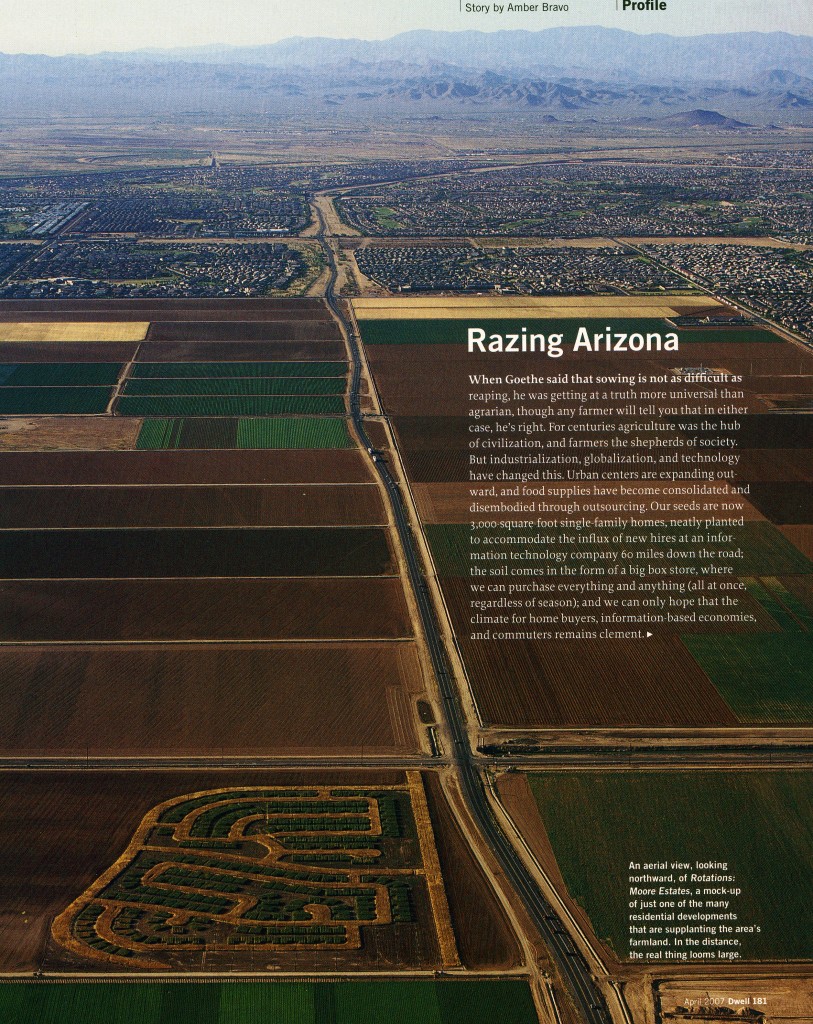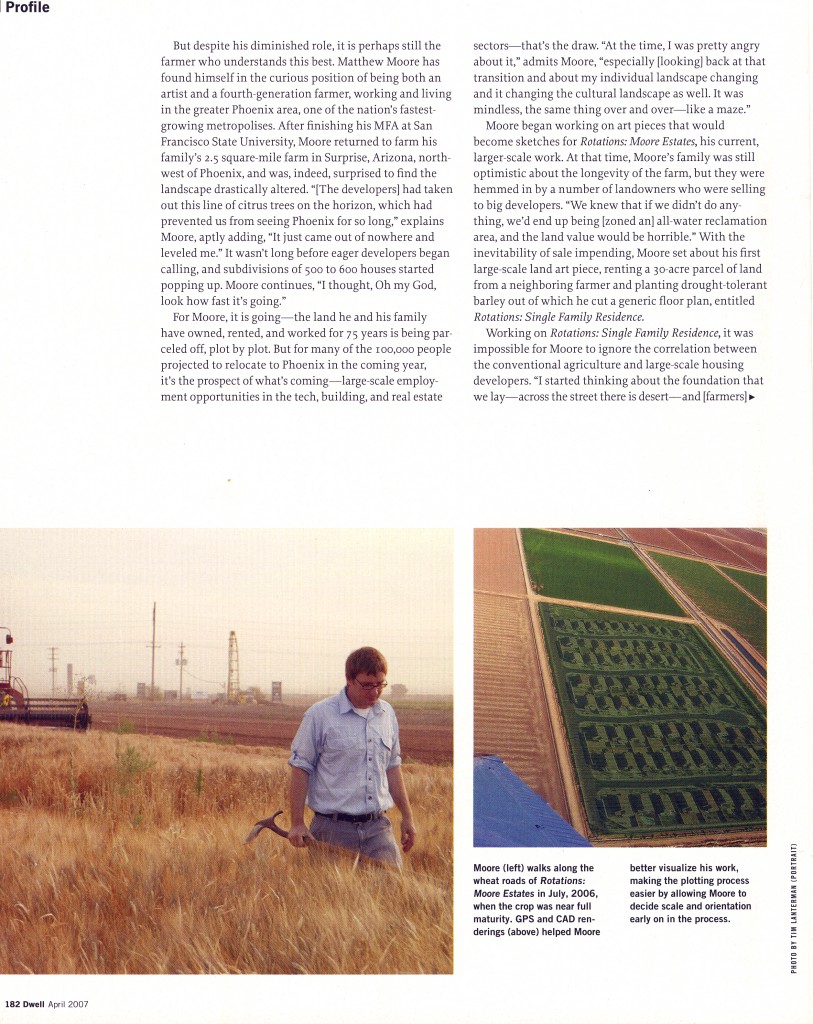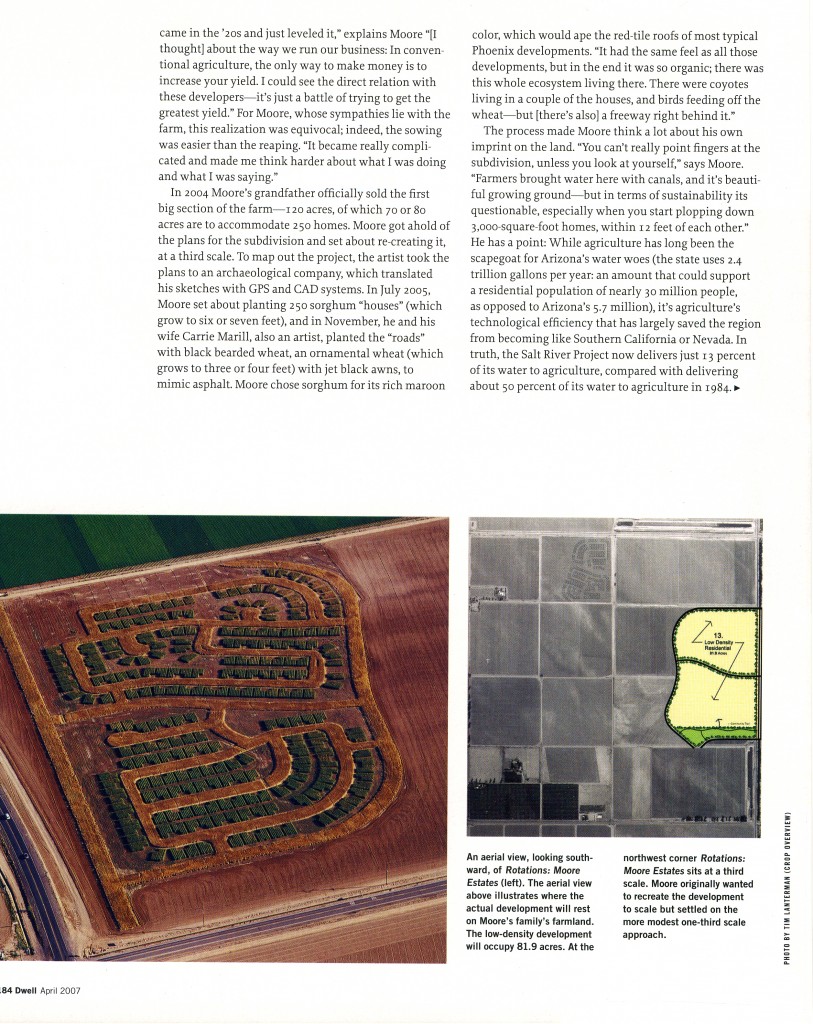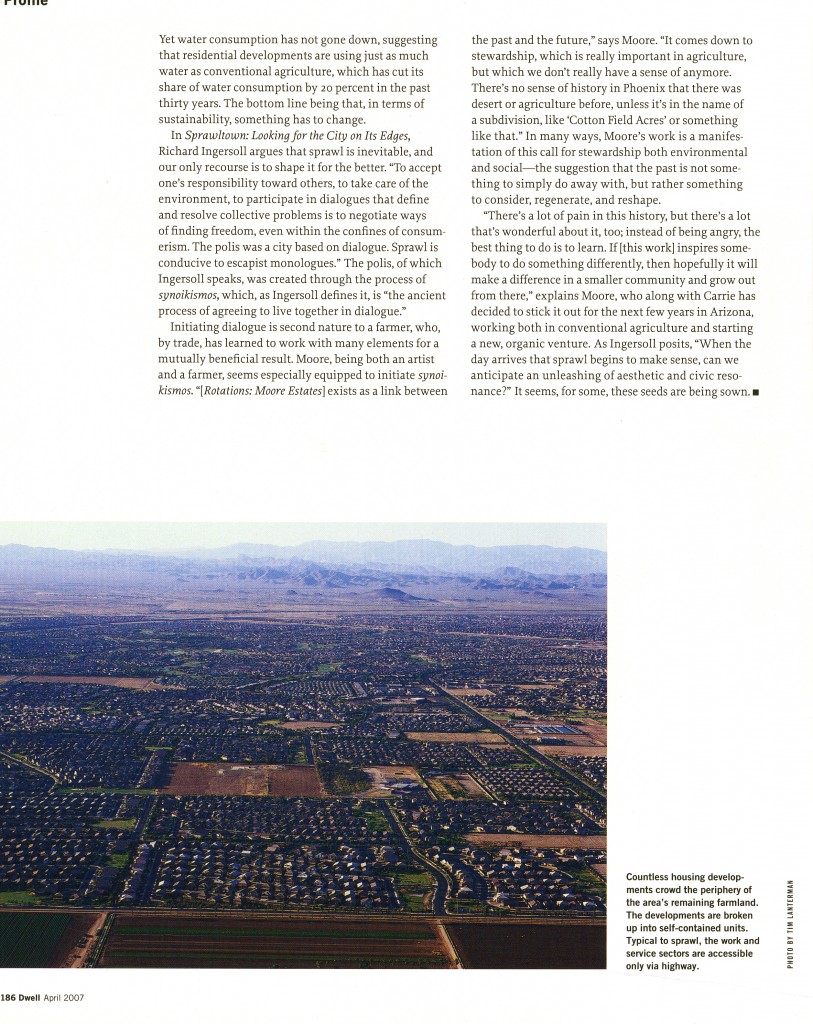Dwell | 2007
Dwell Magazine: “Razing Arizona”
By Amber Bravo
Matthew Moore has found himself in the curious position of being both an artist and a fourth-generation farmer, working and living in the greater Phoenix area, one of the nation’s fastest-growing metropolises.
When Goethe said that sowing is not as difficult as reaping, he was getting at a truth more universal than agrarian, though any farmer will tell you that in either case, he’s right. For centuries agriculture was the hub of civilization, and farmers the shepherds of society. But industrialization, globalization, and technology have changed this. Urban centers are expanding outward, and food supplies have become consolidated and disembodied through outsourcing. Our seeds are now 3,000-square-foot single-family homes, neatly planted to accommodate the influx of new hires at an information technology company 60 miles down the road; the soil comes in the form of a big box store, where we can purchase everything and anything (all at once, regardless of season); and we can only hope that the climate for home buyers, information-based economies, and commuters remains clement.
But despite his diminished role, it is perhaps still the farmer who understands this best. Matthew Moore has found himself in the curious position of being both an artist and a fourth-generation farmer, working and living in the greater Phoenix area, one of the nation’s fastest-growing metropolises. After finishing his MFA at San Francisco State University, Moore returned to farm his family’s 2.5 square-mile farm in Surprise, Arizona, northwest of Phoenix, and was, indeed, surprised to find the landscape drastically altered. “[The developers] had taken out this line of citrus trees on the horizon, which had prevented us from seeing Phoenix for so long,” explains Moore, aptly adding, “It just came out of nowhere and leveled me.” It wasn’t long before eager developers began calling, and subdivisions of 500 to 600 houses started popping up. Moore continues, “I thought, Oh my God, look how fast it’s going.”
For Moore, it is going—the land he and his family have owned, rented, and worked for 75 years is being parceled off, plot by plot. But for many of the 100,000 people projected to relocate to Phoenix in the coming year, it’s the prospect of what’s coming—large-scale employment opportunities in the tech, building, and real estate sectors—that’s the draw. “At the time, I was pretty angry about it,” admits Moore, “especially [looking] back at that transition and about my individual landscape changing and it changing the cultural landscape as well. It was mindless, the same thing over and over—like a maze.”
Moore began working on art pieces that would become sketches for Rotations: Moore Estates, his current, larger-scale work. At that time, Moore’s family was still optimistic about the longevity of the farm, but they were hemmed in by a number of landowners who were selling to big developers. “We knew that if we didn’t do anything, we’d end up being [zoned an] all-water reclamation area, and the land value would be horrible.” With the inevitability of sale impending, Moore set about his first large-scale land art piece, renting a 30-acre parcel of land from a neighboring farmer and planting drought-tolerant barley out of which he cut a generic floor plan, entitled Rotations: Single Family Residence.
Working on Rotations: Single Family Residence, it was impossible for Moore to ignore the correlation between the conventional agriculture and large-scale housing developers. “I started thinking about the foundation that we lay—across the street there is desert—and [farmers] came in the ’20s and just leveled it,” explains Moore “[I thought] about the way we run our business: In conventional agriculture, the only way to make money is to increase your yield. I could see the direct relation with these developers—it’s just a battle of trying to get the greatest yield.” For Moore, whose sympathies lie with the farm, this realization was equivocal; indeed, the sowing was easier than the reaping. “It became really complicated and made me think harder about what I was doing and what I was saying.”
In 2004 Moore’s grandfather officially sold the first big section of the farm—120 acres, of which 70 or 80 acres are to accommodate 250 homes. Moore got a hold of the plans for the subdivision and set about re-creating it, at a third scale. To map out the project, the artist took the plans to an archaeological company, which translated his sketches with GPS and CAD systems. In July 2005, Moore set about planting 250 sorghum “houses” (which grow to six or seven feet), and in November, he and his wife Carrie Marill, also an artist, planted the “roads” with black bearded wheat, an ornamental wheat (which grows to three or four feet) with jet black awns, to mimic asphalt. Moore chose sorghum for its rich maroon color, which would ape the red-tile roofs of most typical Phoenix developments. “It had the same feel as all those developments, but in the end it was so organic; there was this whole ecosystem living there. There were coyotes living in a couple of the houses, and birds feeding off the wheat—but [there’s also] a freeway right behind it.”
The process made Moore think a lot about his own imprint on the land. “You can’t really point fingers at the subdivision, unless you look at yourself,” says Moore. “Farmers brought water here with canals, and it’s beautiful growing ground—but in terms of sustainability its questionable, especially when you start plopping down 3,000-square-foot homes, within 12 feet of each other.” He has a point: While agriculture has long been the scapegoat for Arizona’s water woes (the state uses 2.4 trillion gallons per year: an amount that could support a residential population of nearly 30 million people, as opposed to Arizona’s 5.7 million), it’s agriculture’s technological efficiency that has largely saved the region from becoming like Southern California or Nevada. In truth, the Salt River Project now delivers just 13 percent of its water to agriculture, compared with delivering about 50 percent of its water to agriculture in 1984.
Yet water consumption has not gone down, suggesting that residential developments are using just as much water as conventional agriculture, which has cut its share of water consumption by 20 percent in the past thirty years. The bottom line being that, in terms of sustainability, something has to change.
In Sprawltown: Looking for the City on Its Edges</i>, Richard Ingersoll argues that sprawl is inevitable, and our only recourse is to shape it for the better. “To accept one’s responsibility toward others, to take care of the environment, to participate in dialogues that define and resolve collective problems is to negotiate ways of finding freedom, even within the confines of consumerism. The polis was a city based on dialogue. Sprawl is conducive to escapist monologues.” The polis, of which Ingersoll speaks, was created through the process ofsynoikismos, which, as Ingersoll defines it, is “the ancient process of agreeing to live together in dialogue.”
Initiating dialogue is second nature to a farmer, who, by trade, has learned to work with many elements for a mutually beneficial result. Moore, being both an artist and a farmer, seems especially equipped to initiate synoikismos. [Rotations: Moore Estates] exists as a link between the past and the future,” says Moore. “It comes down to stewardship, which is really important in agriculture, but which we don’t really have a sense of anymore. There’s no sense of history in Phoenix that there was desert or agriculture before, unless it’s in the name of a subdivision, like ‘Cotton Field Acres’ or something like that.” In many ways, Moore’s work is a manifestation of this call for stewardship both environmental and social—the suggestion that the past is not something to simply do away with, but rather something to consider, regenerate, and reshape.
“There’s a lot of pain in this history, but there’s a lot that’s wonderful about it, too; instead of being angry, the best thing to do is to learn. If [this work] inspires somebody to do something differently, then hopefully it will make a difference in a smaller community and grow out from there,” explains Moore, who along with Carrie has decided to stick it out for the next few years in Arizona, working both in conventional agriculture and starting a new, organic venture. As Ingersoll posits, “When the day arrives that sprawl begins to make sense, can we anticipate an unleashing of aesthetic and civic resonance?” It seems, for some, these seeds are being sown.






